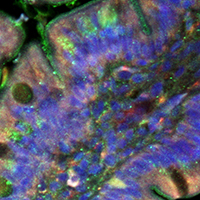Distribution of alpha-synuclein in normal human jejunum and its relations with the chemosensory and neuroendocrine system

Accepted: 8 September 2021
HTML: 45
All claims expressed in this article are solely those of the authors and do not necessarily represent those of their affiliated organizations, or those of the publisher, the editors and the reviewers. Any product that may be evaluated in this article or claim that may be made by its manufacturer is not guaranteed or endorsed by the publisher.
Authors
Alpha-synuclein (α-syn) is a presynaptic neuronal protein and its structural alterations play an important role in the pathogenesis of neurodegenerative diseases, such as Parkinson’s disease (PD). It has been originally described in the brain and aggregated α-syn has also been found in the peripheral nerves including the enteric nervous system (ENS) of PD patients. ENS is a network of neurons and glia found in the gut wall which controls gastrointestinal function independently from the central nervous system. Moreover, two types of epithelial cells are crucial in the creation of an interface between the lumen and the ENS: they are the tuft cells and the enteroendocrine cells (EECs). In addition, the abundant enteric glial cells (EGCs) in the intestinal mucosa play a key role in controlling the intestinal epithelial barrier. Our aim was to localize and characterize the presence of α-syn in the normal human jejunal wall. Surgical specimens of proximal jejunum were collected from patients submitted to pancreaticoduodenectomy and intestinal sections underwent immunohistochemical procedure. Alpha-syn has been found both at the level of ENS and the epithelial cells. To characterize α-syn immunoreactive epithelial cells, we used markers such as choline acetyltransferase (ChAT), useful for the identification of tuft cells. Then we evaluated the co-presence of α-syn with serotonin (5-HT), expressed in EECs. Finally, we used the low-affinity nerve growth factor receptor (p75NTR), to detect peripheral EGCs. The presence of α-syn has been demonstrated in EECs, but not in the tuft cells. Additionally, p75NTR has been highlighted in EECs of the mucosal layer and co-localized with α-syn in EECs but not with ChAT-positive cells. These findings suggest that α-syn could play a possible role in synaptic transmission of the ENS and may contribute to maintain the integrity of the epithelial barrier of the small intestine through EECs.
How to Cite

This work is licensed under a Creative Commons Attribution-NonCommercial 4.0 International License.
PAGEPress has chosen to apply the Creative Commons Attribution NonCommercial 4.0 International License (CC BY-NC 4.0) to all manuscripts to be published.

 https://doi.org/10.4081/ejh.2021.3310
https://doi.org/10.4081/ejh.2021.3310






